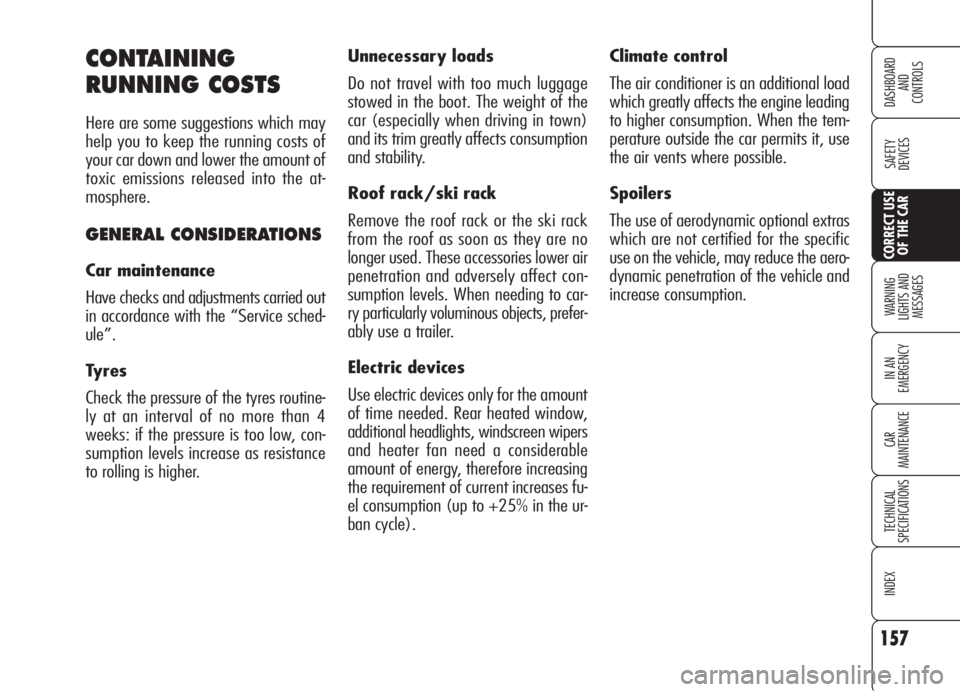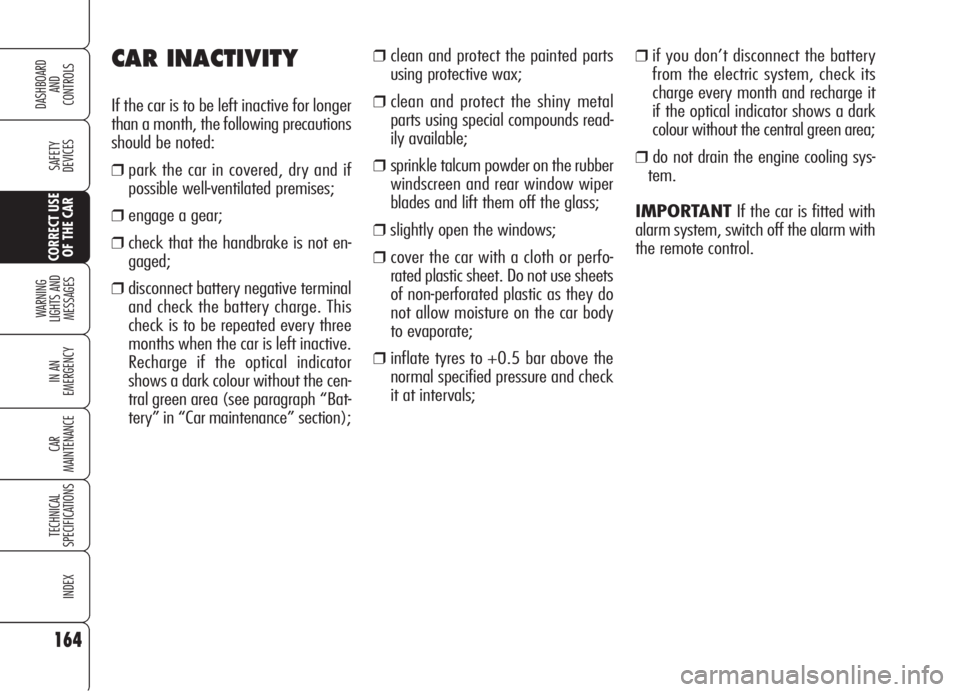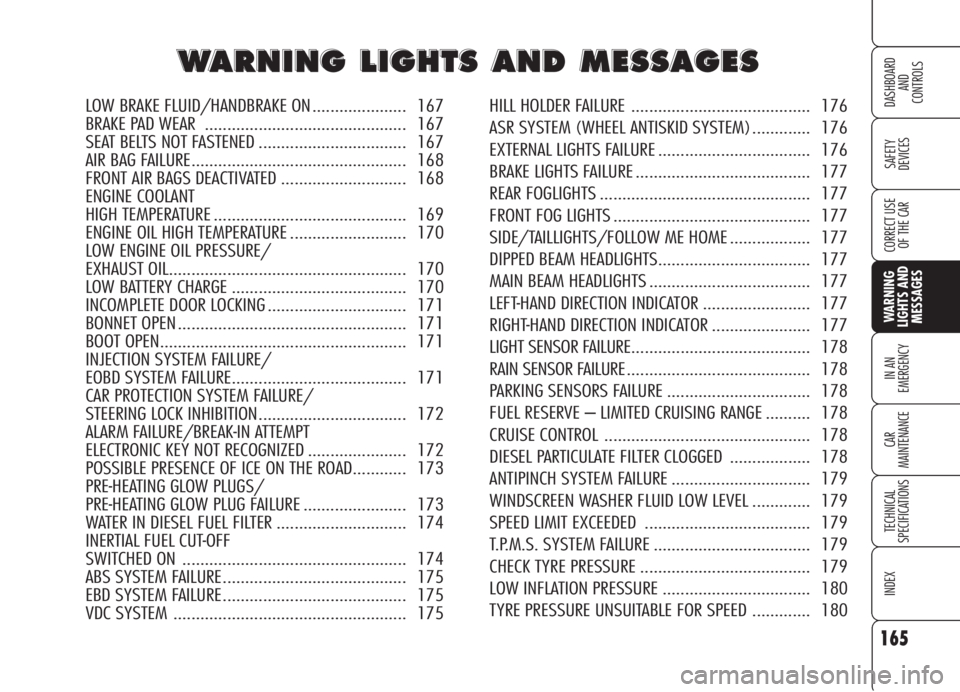pressure Alfa Romeo 159 2006 Owner handbook (in English)
[x] Cancel search | Manufacturer: ALFA ROMEO, Model Year: 2006, Model line: 159, Model: Alfa Romeo 159 2006Pages: 299, PDF Size: 4.64 MB
Page 159 of 299

157
SAFETY
DEVICES
WARNING
LIGHTS AND
MESSAGES
IN AN
EMERGENCY
CAR
MAINTENANCE
TECHNICAL
SPECIFICATIONS
INDEX
DASHBOARD
AND
CONTROLS
CORRECT USE
OF THE CAR
Climate control
The air conditioner is an additional load
which greatly affects the engine leading
to higher consumption. When the tem-
perature outside the car permits it, use
the air vents where possible.
Spoilers
The use of aerodynamic optional extras
which are not certified for the specific
use on the vehicle, may reduce the aero-
dynamic penetration of the vehicle and
increase consumption. Unnecessary loads
Do not travel with too much luggage
stowed in the boot. The weight of the
car (especially when driving in town)
and its trim greatly affects consumption
and stability.
Roof rack/ski rack
Remove the roof rack or the ski rack
from the roof as soon as they are no
longer used. These accessories lower air
penetration and adversely affect con-
sumption levels. When needing to car-
ry particularly voluminous objects, prefer-
ably use a trailer.
Electric devices
Use electric devices only for the amount
of time needed. Rear heated window,
additional headlights, windscreen wipers
and heater fan need a considerable
amount of energy, therefore increasing
the requirement of current increases fu-
el consumption (up to +25% in the ur-
ban cycle).CONTAINING
RUNNING COSTS
Here are some suggestions which may
help you to keep the running costs of
your car down and lower the amount of
toxic emissions released into the at-
mosphere.
GENERAL CONSIDERATIONS
Car maintenance
Have checks and adjustments carried out
in accordance with the “Service sched-
ule”.
Tyres
Check the pressure of the tyres routine-
ly at an interval of no more than 4
weeks: if the pressure is too low, con-
sumption levels increase as resistance
to rolling is higher.
Page 164 of 299

162
SAFETY
DEVICES
WARNING
LIGHTS AND
MESSAGES
IN AN
EMERGENCY
CAR
MAINTENANCE
TECHNICAL
SPECIFICATIONS
INDEX
DASHBOARD
AND
CONTROLS
CORRECT USE
OF THE CAR
Due to the snow tyre features, under
normal conditions of use or on long mo-
torway journeys, the performance of
these tyres is lower than that of normal
tyres. It is therefore necessary to limit
their use to the purposes for which they
are certified.
IMPORTANTWhen snow tyres are
used with a max speed index below the
one that can be reached by the car (in-
creased by 5%), place a notice in the
passenger compartment, plainly in the
driver’s view which states the max per-
missible speed of the snow tyres (as per
EC Directive).
All four tyres should be the same (brand
and track) to ensure greater safety
when driving and braking and better dri-
veability.
Remember that it is inappropriate to
change the direction of rotation of tyres.SNOW TYRES
Use snow tyres of the same size as the
normal tyres provided with the car.
Alfa Romeo Authorized Services will be
glad to provide advice concerning the
most suitable type of tyre for the cus-
tomer’s requirements.
For the type of tyre to be used, inflation
pressures and the specifications of snow
tyres, follow the instructions given in para-
graph “Wheels” in section “Technical
specifications”.
The winter features of these tyres are re-
duced considerably when the tread
depth is below 4 mm. In this case, they
should be replaced.
The max speed for
snow tyres with “Q”
marking is 160 km/h; 190
km/h for tyres with “T”
marking and 210 km/h for
tyres with H marking. The
Road Traffic Code speed lim-
its must however be always
strictly observed.
WARNING
Page 165 of 299

163
SAFETY
DEVICES
WARNING
LIGHTS AND
MESSAGES
IN AN
EMERGENCY
CAR
MAINTENANCE
TECHNICAL
SPECIFICATIONS
INDEX
DASHBOARD
AND
CONTROLS
CORRECT USE
OF THE CAR
IMPORTANTSnow chains cannot be
fitted to the space-saver spare wheel.
So, if a front (drive) wheel is punctured
and chains are needed, a rear wheel
should be fitted to the front of the car
and the spare wheel should be fitted to
the rear (adjust tyre pressure to the spec-
ified value as soon as possible). This
way with two normal drive wheels,
snow chains can be fitted to them to
solve an emergency.
Tyres 235/45 R18” can-
not be fitted with snow
chains due to interference
with the fender. On 3.2 JTS version snow
chains shall be fitted to
FRONT wheels.SNOW CHAINS
Use of snow chains should be in compli-
ance with local regulations.
Snow chains should only be applied to
the driving wheels (front wheels).
Check the tension of the chains after the
first few metres have been driven.
Use snow chains with reduced size: for
tyres 205/55 R16” and 215/55
R16” use snow chains with reduced size
with max protrusion beyond the tyre pro-
file of 9 mm.
Use of snow chains may be compulso-
ry also for cars with four-wheel drive.
Traditional snow chains
may not be used on tyres
type 225/50 R17” on-
ly spider type chains can be used.
Keep your speed down
when snow chains are
fitted. Do not exceed
40 km/h. Avoid pot-
holes, steps and pave-
ments and avoid also to drive
for long distances on roads not
covered with snow to prevent
damaging the car and the
roadbed.
WARNING
When snow chains are
fitted, switch the ASR
system off. Press the
ASR/VDC button (see para-
graph “ASR system” in section
“Dashboard and controls”).
Page 166 of 299

164
SAFETY
DEVICES
WARNING
LIGHTS AND
MESSAGES
IN AN
EMERGENCY
CAR
MAINTENANCE
TECHNICAL
SPECIFICATIONS
INDEX
DASHBOARD
AND
CONTROLS
CORRECT USE
OF THE CAR
CAR INACTIVITY
If the car is to be left inactive for longer
than a month, the following precautions
should be noted:
❒ park the car in covered, dry and if
possible well-ventilated premises;
❒ engage a gear;
❒check that the handbrake is not en-
gaged;
❒disconnect battery negative terminal
and check the battery charge. This
check is to be repeated every three
months when the car is left inactive.
Recharge if the optical indicator
shows a dark colour without the cen-
tral green area (see paragraph “Bat-
tery” in “Car maintenance” section);
❒clean and protect the painted parts
using protective wax;
❒clean and protect the shiny metal
parts using special compounds read-
ily available;
❒sprinkle talcum powder on the rubber
windscreen and rear window wiper
blades and lift them off the glass;
❒slightly open the windows;
❒cover the car with a cloth or perfo-
rated plastic sheet. Do not use sheets
of non-perforated plastic as they do
not allow moisture on the car body
to evaporate;
❒inflate tyres to +0.5 bar above the
normal specified pressure and check
it at intervals;
❒if you don’t disconnect the battery
from the electric system, check its
charge every month and recharge it
if the optical indicator shows a dark
colour without the central green area;
❒do not drain the engine cooling sys-
tem.
IMPORTANTIf the car is fitted with
alarm system, switch off the alarm with
the remote control.
Page 167 of 299

165
SAFETY
DEVICES
IN AN
EMERGENCY
CAR
MAINTENANCE
TECHNICAL
SPECIFICATIONS
INDEX
CORRECT USE
OF THE CAR
DASHBOARD
AND
CONTROLS
WARNING
LIGHTS AND
MESSAGES
W W
A A
R R
N N
I I
N N
G G
L L
I I
G G
H H
T T
S S
A A
N N
D D
M M
E E
S S
S S
A A
G G
E E
S S
LOW BRAKE FLUID/HANDBRAKE ON ..................... 167
BRAKE PAD WEAR ............................................. 167
SEAT BELTS NOT FASTENED ................................. 167
AIR BAG FAILURE................................................ 168
FRONT AIR BAGS DEACTIVATED ............................ 168
ENGINE COOLANT
HIGH TEMPERATURE ........................................... 169
ENGINE OIL HIGH TEMPERATURE .......................... 170
LOW ENGINE OIL PRESSURE/
EXHAUST OIL..................................................... 170
LOW BATTERY CHARGE ....................................... 170
INCOMPLETE DOOR LOCKING ............................... 171
BONNET OPEN ................................................... 171
BOOT OPEN....................................................... 171
INJECTION SYSTEM FAILURE/
EOBD SYSTEM FAILURE....................................... 171
CAR PROTECTION SYSTEM FAILURE/
STEERING LOCK INHIBITION................................. 172
ALARM FAILURE/BREAK-IN ATTEMPT
ELECTRONIC KEY NOT RECOGNIZED ...................... 172
POSSIBLE PRESENCE OF ICE ON THE ROAD............ 173
PRE-HEATING GLOW PLUGS/
PRE-HEATING GLOW PLUG FAILURE ....................... 173
WATER IN DIESEL FUEL FILTER ............................. 174
INERTIAL FUEL CUT-OFF
SWITCHED ON .................................................. 174
ABS SYSTEM FAILURE......................................... 175
EBD SYSTEM FAILURE......................................... 175
VDC SYSTEM .................................................... 175HILL HOLDER FAILURE ........................................ 176
ASR SYSTEM (WHEEL ANTISKID SYSTEM) ............. 176
EXTERNAL LIGHTS FAILURE .................................. 176
BRAKE LIGHTS FAILURE ....................................... 177
REAR FOGLIGHTS ............................................... 177
FRONT FOG LIGHTS ............................................ 177
SIDE/TAILLIGHTS/FOLLOW ME HOME .................. 177
DIPPED BEAM HEADLIGHTS.................................. 177
MAIN BEAM HEADLIGHTS .................................... 177
LEFT-HAND DIRECTION INDICATOR ........................ 177
RIGHT-HAND DIRECTION INDICATOR ...................... 177
LIGHT SENSOR FAILURE........................................ 178
RAIN SENSOR FAILURE......................................... 178
PARKING SENSORS FAILURE ................................ 178
FUEL RESERVE – LIMITED CRUISING RANGE .......... 178
CRUISE CONTROL .............................................. 178
DIESEL PARTICULATE FILTER CLOGGED .................. 178
ANTIPINCH SYSTEM FAILURE ............................... 179
WINDSCREEN WASHER FLUID LOW LEVEL ............. 179
SPEED LIMIT EXCEEDED ..................................... 179
T.P.M.S. SYSTEM FAILURE ................................... 179
CHECK TYRE PRESSURE ...................................... 179
LOW INFLATION PRESSURE ................................. 180
TYRE PRESSURE UNSUITABLE FOR SPEED ............. 180
Page 172 of 299

170
SAFETY
DEVICES
IN AN
EMERGENCY
CAR
MAINTENANCE
TECHNICAL
SPECIFICATIONS
INDEX
CORRECT USE
OF THE CAR
DASHBOARD
AND
CONTROLS
WARNING
LIGHTS AND
MESSAGES
ENGINE OIL
HIGH TEMPERATURE
Fitting the key into the ignition
device, the warning light (set on engine
oil temperature gauge) turns on but it
should go off after a few seconds. Warn-
ing light turning on when travelling (on
certain versions together with the mes-
sage on the display) indicates that en-
gine oil is too hot; switch the engine off
and contact Alfa Romeo Authorized Ser-
vices.
If warning light
`
starts flashing when
travelling contact Alfa
Romeo Authorized Services.
LOW ENGINE
OIL PRESSURE
EXHAUST OIL
(diesel versions)
Low engine oil pressure
On certain versions, fitting the key into
the ignition device, the warning light
turns on but it should go off as soon as
the engine has started.After the first indication, at each engine
starting the warning light
vwill go
on flashing for about 1 minute and then
every 2 hours until oil is changed.
LOW BATTERY
CHARGE (red)
The warning light (where pro-
vided) turns on, but it should go off as
soon as the engine has started (with the
engine running at idle speed a brief de-
lay in going out is allowed).
If the warning light (or as an alternative,
on certain versions, a symbol and a mes-
sage are displayed) stays on glowing
steadily or flashing contact immediate-
ly Alfa Romeo Authorized Services.
w
`v
If the warning light
(or as an alternative,
on certain versions, a symbol
and a message are displayed)
comes on when travelling,
stop immediately and contact
Alfa Romeo Authorized Ser-
vices.
WARNING
If warning light v
starts flashing, contact
Alfa Romeo Authorized
Services as soon as possible to
have the engine oil changed and
the instrument panel (or symbol
von the display) switched
off.
Exhaust oil (diesel versions)
The warning light (where provided) with
turn on flashing (on certain versions a
message is displayed) when the system
detects that the engine oil is exhaust.
Page 181 of 299

179
SAFETY
DEVICES
IN AN
EMERGENCY
CAR
MAINTENANCE
TECHNICAL
SPECIFICATIONS
INDEX
CORRECT USE
OF THE CAR
DASHBOARD
AND
CONTROLS
WARNING
LIGHTS AND
MESSAGES
ANTIPINCH SYSTEM
FAILURE
(amber)
The warning light (or as an alternative,
on certain versions, a symbol and a mes-
sage are displayed) turns on when a fail-
ure is detected in the antipinch system.
Contact Alfa Romeo Authorized Services.
WINDSCREEN
WASHER FLUID
LOW LEVEL (amber)
The warning light (where provided)
turns on (on certain versions a message
is displayed) when the windscreen
washer fluid level falls down the preset
min. level.
5
)
SPEED LIMIT
EXCEEDED
The display will show a warn-
ing message + symbol (red) and the
buzzer will sound when the car exceeds
the speed limit set through the “Setup
menu” (e.g.: 120 km/h) (see para-
graphs “Multifunction Display” or “Re-
configurable Multifunction Display” in
section “Dashboard and controls”).
T.P.M.S. SYSTEM
FAILURE
(where provided)
On certain versions the display will show
a warning message + symbol (amber)
when a failure is detected in the T.P.M.S.
system (Tyre Pressure Monitoring Sys-
tem). Contact Alfa Romeo Authorized
Services as soon as possible.
Should one or more wheels without sen-
sor be fitted, the display will show a
warning message until initial conditions
are restored.
CHECK TYRE
PRESSURE
(where provided)
On certain versions the display will show
a warning message + symbol (amber)
to indicate the flat tyre.
Should two or more tyre be flat, the dis-
play will show the indications corre-
sponding to each tyre in sequence.
Restore proper inflation pressure values
as soon as possible (see paragraph
“Cold inflation pressures” in section
“Technical Specifications”).
X
n
n
Page 182 of 299

180
SAFETY
DEVICES
IN AN
EMERGENCY
CAR
MAINTENANCE
TECHNICAL
SPECIFICATIONS
INDEX
CORRECT USE
OF THE CAR
DASHBOARD
AND
CONTROLS
WARNING
LIGHTS AND
MESSAGES
LOW TYRE
PRESSURE
(where provided)
On certain versions the display will show
a warning message + symbol (red) (and
buzzer will sound) when the pressure of
one or more tyres falls below the preset
threshold. In this way the T.P.M.S. sys-
tem warns the driver that tyre/s is/are
dangerously flat; possible puncture.
IMPORTANTStop immediately with
one or more tyres flat, avoid braking
sharply and abrupt turns. Replace im-
mediately the punctured tyre with the
space-saver spare wheel (where provid-
ed) or repair the puncture tyre using the
proper kit (see paragraph “If a tyre is
punctured” in section “In an emer-
gency”) and then contact Alfa Romeo Au-
thorized Services as soon as possible.
TYRE PRESSURE
UNSUITABLE FOR
SPEED
(where provided)
Should it be required to journey at a
speed higher than 160 km/h, inflate
tyres at full load pressures (see paragraph
“Cold inflation pressures” in section "Tech-
nical Specifications").
On certain versions, if the T.P.M.S. sys-
tem detects that the pressure of one or
more tyres is unsuitable for the current
speed the display will show a message +
symbol (amber) that will stay on until the
car speed slow downs below the preset
threshold.IMPORTANT In this case slow down
immediately since tyre overheating could
impair tyre performance and life beyond
repair, and even make the tyre to blow-
out.
IMPORTANT Should you have to jour-
ney anyway a speed higher than 160
km/h, stop the car when the display
shows the warning symbol to inflate tyres
to the proper pressure values (see para-
graph "Cold inflation pressures" in section
"Technical Specifications ").
nn
Page 187 of 299

185
SAFETY
DEVICES
WARNING
LIGHTS AND
MESSAGES
CAR
MAINTENANCE
TECHNICAL
SPECIFICATIONS
INDEX
CORRECT USE
OF THE CAR
DASHBOARD
AND
CONTROLS
IN AN
EMERGENCY
Please note:
❒the jack weight is 1.76 kg;
❒the jack requires no adjustment;
❒the jack cannot be repaired. If it
breaks it must be replaced with a
new jack;
❒no tool other than its cranking device
may be fitted on the jack.To change a wheel proceed as follows:
❒Stop the car in a position that is not
dangerous for oncoming traffic where
you can change the wheel safely. The
ground should be flat and adequate-
ly firm;
❒Turn the engine off, pull up the hand-
brake and engage first gear or re-
verse;
❒Using handle A-fig. 2, lift the stiff
coverBand secure it as shown in
fig. 3;
Never tamper with the
inflation valve. Never
place tools between the rim
and tyre. Check and restore, if
required, the pressure of tyres
and spare wheel to the values
given in section “Technical
Specifications”.
WARNING
A0E0132mfig. 2A0E0133mfig. 3
Page 192 of 299

190
SAFETY
DEVICES
WARNING
LIGHTS AND
MESSAGES
CAR
MAINTENANCE
TECHNICAL
SPECIFICATIONS
INDEX
CORRECT USE
OF THE CAR
DASHBOARD
AND
CONTROLS
IN AN
EMERGENCY
The quick tyre repair kit includes:
❒a bottle A-fig. 14containing the
sealer, fitted with:
- filling pipe B
- sticker Cbearing the notice “max.
80 km/h”, to be placed in a posi-
tion visible to the driver (on the in-
strument panel) after fixing the tyre;
❒compressorDwith pressure gauge
and fittings;
QUICK TYRE REPAIR
KIT FIX&GO
automatic
The car is provided with the quick tyre
repair kit “FIX&GO automatic”, instead
of the traditional tool kit and space-saver
spare wheel.
The kit fig. 14is placed in the boot. In
this container are also housed the screw-
driver and the tow hitch.
A0E0114mfig. 14A0E0048mfig. 15
❒instruction brochurefig. 15, to be
used for prompt and proper use of the
quick repair kit and to be then hand-
ed to the personnel charged with han-
dling the tyre treated with the tyre re-
pair kit;
❒a pair of protection gloves located in
the side space of the compressor;
❒adapters for inflating different ele-
ments.